
COMPUTER SCIENCE ILLUMIN.-TEXT
6th Edition
ISBN: 2810016866372
Author: Dale
Publisher: JONES+BART
expand_more
expand_more
format_list_bulleted
Question
Chapter 8, Problem 47E
Program Plan Intro
Binary search tree:
- Binary search tree is a tree; the nodes are sorted in the semantic order.
- Binary search tree nodes can have zero, one, or two children.
- Node without children is called a leaf or end node.
- A node that does not have a superior node is called a root node or starting node.
- In binary search tree, the left subtree contains the nodes lesser than the root node.
- The right subtree contains the nodes greater than the root node.
- The binary search will performed until finding a search node or reaching the end of the tree.
Expert Solution & Answer
Explanation of Solution
Insertion of elements in the binary search tree:
Given elements to construct a binary search tree are as follows:
50, 72, 96, 107, 26, 12, 11, 9, 2, 10, 25, 51, 16, 17, 95.
Step 1:
Insert the element 50, which is the root node of a binary search tree.

Step 2:
Next element is 72, which is greater than root node element 50, so insert the element 72 as the right child of the root node.
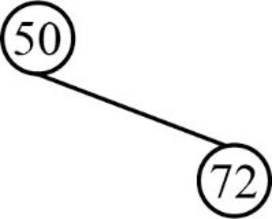
Step 3:
- Next element is 96, which is greater than root node element 50, so insert the element 96 as the right child of the root node.
- The root node already contains the element 72 as the right child and the element 96 is greater than the element 72.
- So, insert the element 96 as the right child of 72.
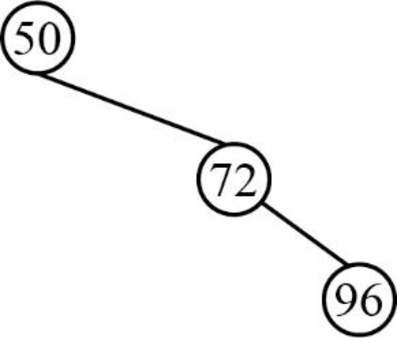
Step 4:
- Next element is 107, which is greater than root node element 50, so insert the element 107 as the right child of the root node.
- The root node already contains the element 72 as the right child and the element 107 is greater than the element 72.
- The element 72 already contains the element 96 as the right child and the element 107 is greater than the element 96.
- So, insert the element 107 as the right child of 96.
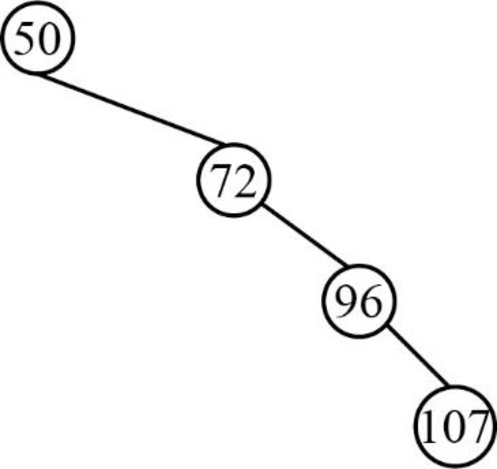
Step 5:
Next element is 26, which is less than root node value 50, so insert the element 26 as the left child of the root node.
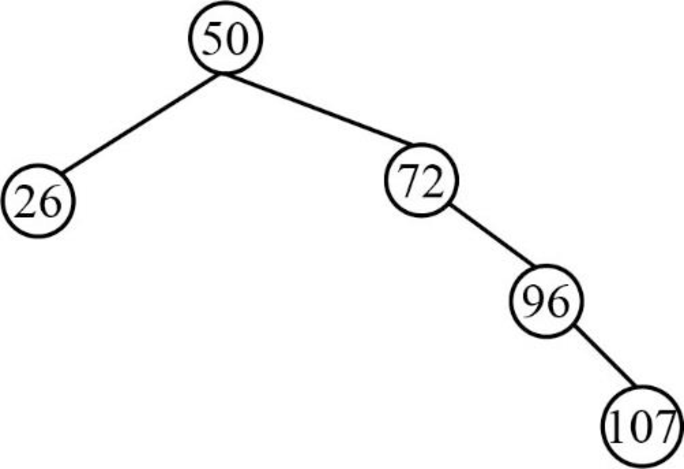
Step 6:
- Next element is 12, which is less than the root node value 50, so insert the element 12 as left child of the root node.
- The root node already contains the element 26 as the left child and the element 12 is less than the element 26.
- So, insert the element 12 as left child of the element 26.
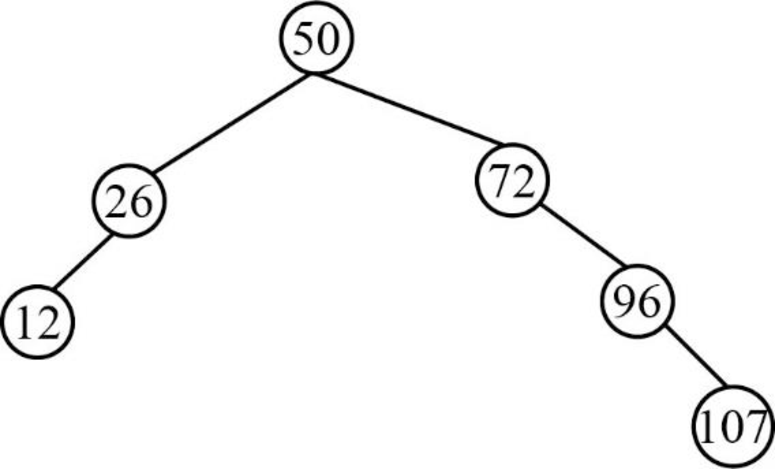
Step 7:
- Next element is 11, which is less than the root node value 50, so insert the element 11 as left child of the root node.
- The root node already contains the element 26 as the left child and the element 11 is less than the element 26.
- The element 26 already contains the element 12 as the left child and the element 11 is lesser than the element 12.
- So, insert the element 11 as left child of the element 12.
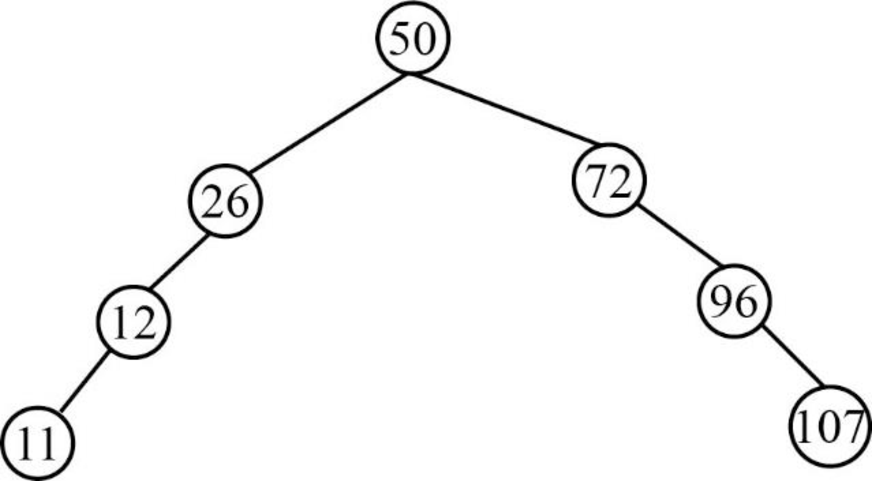
Step 8:
- Next element is 9, which is less than the root node value 50, so insert the element 9 as left child of the root node.
- The root node already contains the element 26 as the left child and the element 9 is less than the element 26.
- The element 26 already contains the element 12 as the left child and the element 9 is lesser than the element 12.
- The element 12 already contains the element 11 as the left child and the element 9 is lesser than the element 11.
- So, insert the element 9 as left child of the element 11.
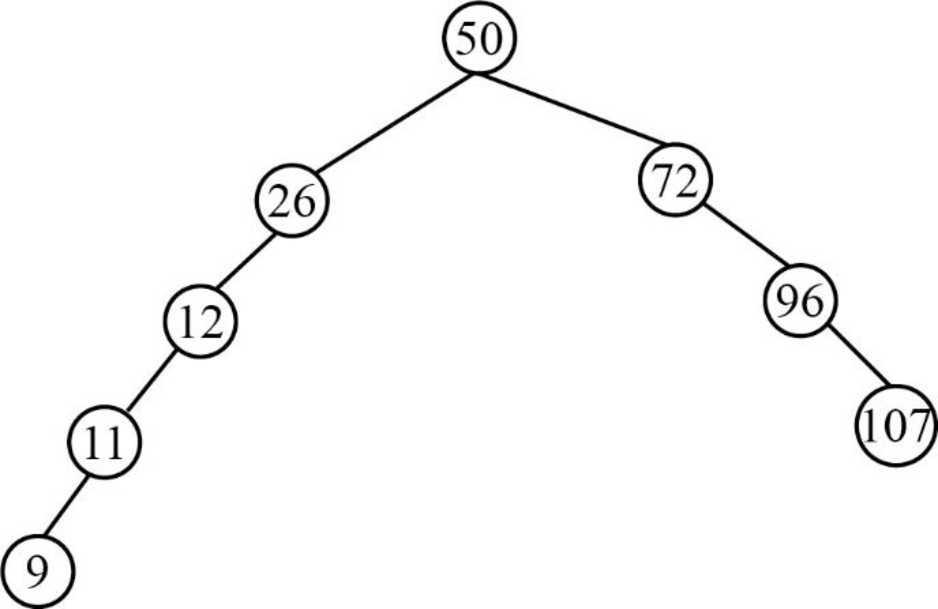
Step 9:
- Next element is 2, which is less than the root node value 50, so insert the element 2 as left child of the root node.
- The root node already contains the element 26 as the left child and the element 2 is less than the element 26.
- The element 26 already contains the element 12 as the left child and the element 2 is lesser than the element 12.
- The element 12 already contains the element 11 as the left child and the element 2 is lesser than the element 11.
- The element 11 already contains the element 9 as the left child and the element 2 is lesser than the element 9.
- So, insert the element 2 as left child of the element 9.
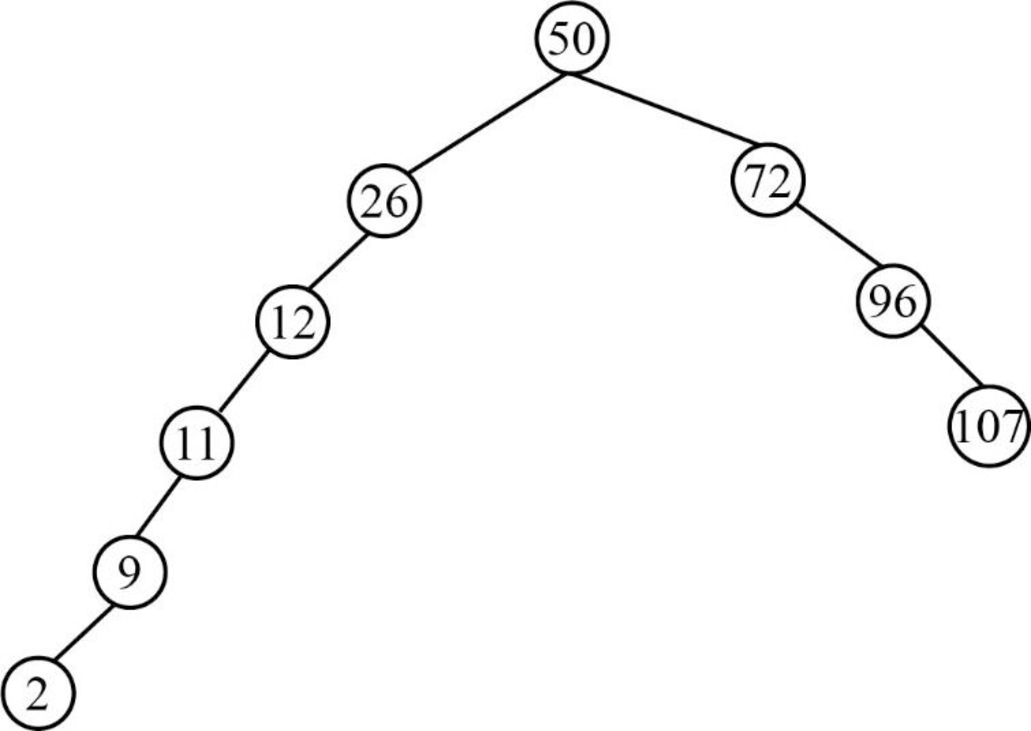
Step 10:
- Next element is 10, which is less than the root node value 50, so insert the element 10 as left child of the root node.
- The root node already contains the element 26 as the left child and the element 10 is less than the element 26.
- The element 26 already contains the element 12 as the left child and the element 10 is lesser than the element 12.
- The element 12 already contains the element 11 as the left child and the element 10 is lesser than the element 11.
- The element 11 already contains the element 9 as the left child and the element 10 is greater than the element 9.
- So, insert the element 10 as right child of the element 9.
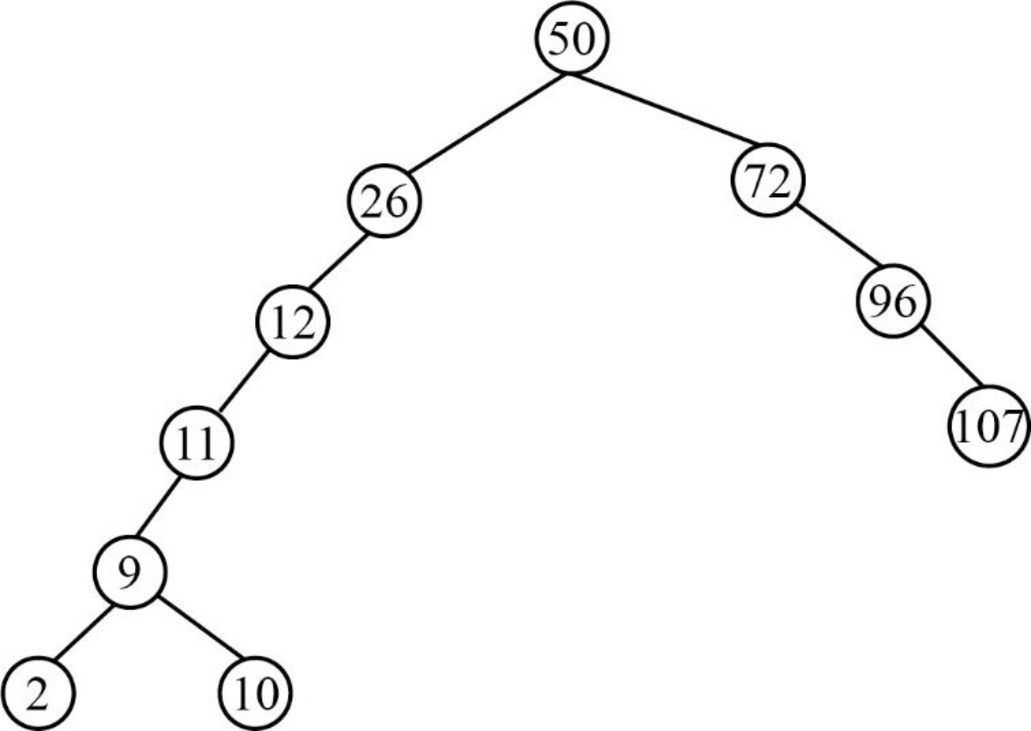
Step 11:
- Next element is 25, which is less than the root node value 50, so insert the element 25 as left child of the root node.
- The root node already contains the element 26 as the left child and the element 25 is less than the element 26.
- The element 26 already contains the element 12 as the left child and the element 25 is greater than the element 12.
- So, insert the element 25 as right child of the element 12.
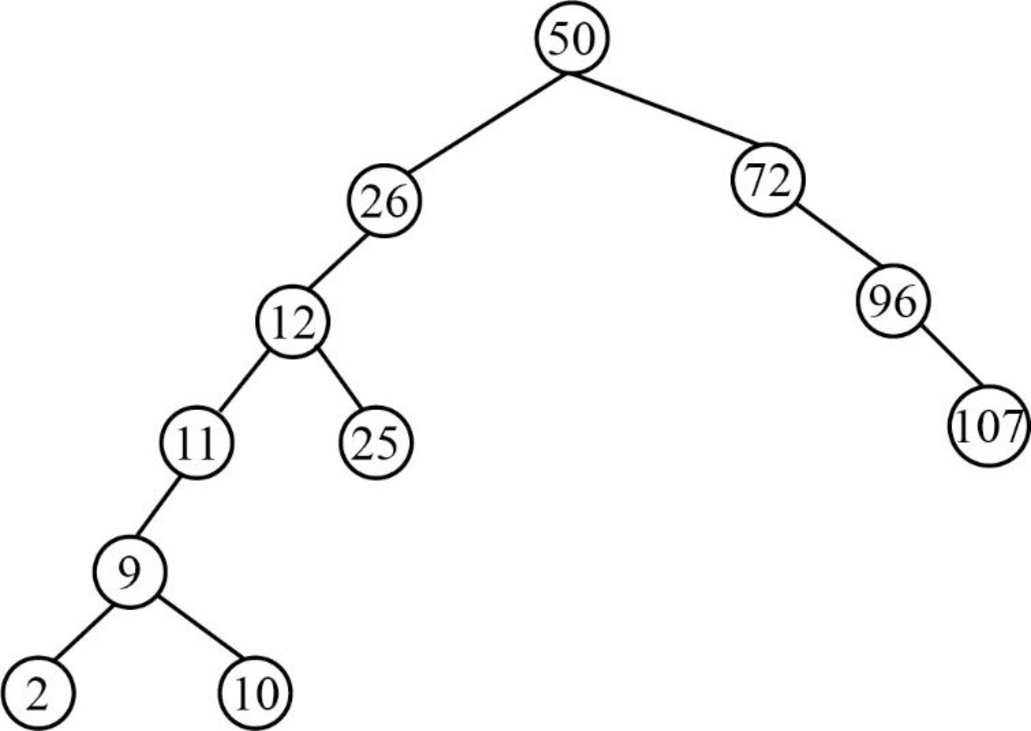
Step 12:
- Next element is 51, which is greater than root node element 50, so insert the element 51 as the right child of the root node.
- The root node already contains the element 72 as the right child and the element 51 is lesser than the element 72.
- So, insert the element 51 as the left child of 72.
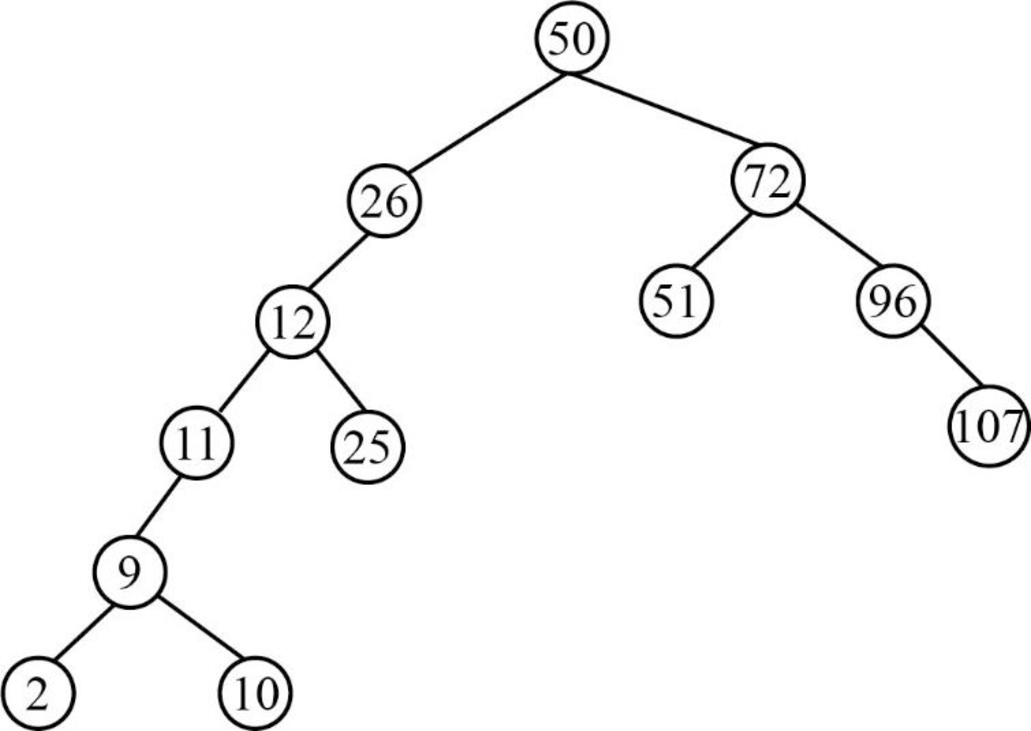
Step 13:
- Next element is 16, which is less than the root node value 50, so insert the element 16 as left child of the root node.
- The root node already contains the element 26 as the left child and the element 16 is less than the element 26.
- The element 26 already contains the element 12 as the left child and the element 16 is greater than the element 12.
- The element 12 already contains the element 25 as the right child and the element 16 is lesser than the element 25.
- So, insert the element 16 as left child of the element 25.
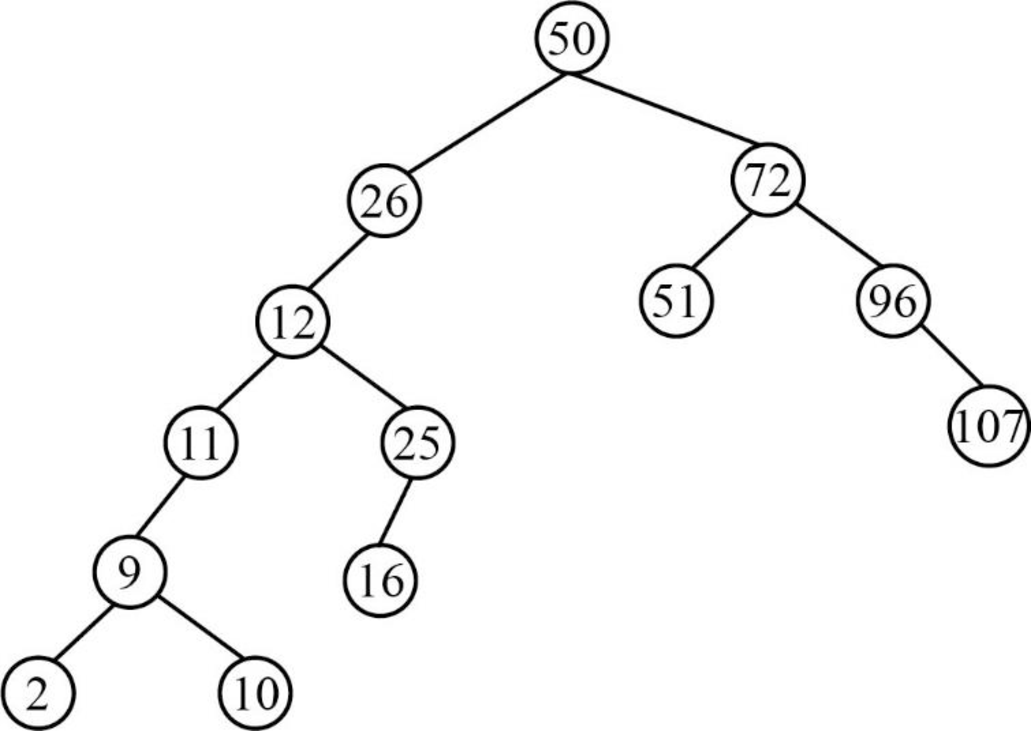
Step 14:
- Next element is 17, which is less than the root node value 50, so insert the element 17 as left child of the root node.
- The root node already contains the element 26 as the left child and the element 17 is less than the element 26.
- The element 26 already contains the element 12 as the left child and the element 17 is greater than the element 12.
- The element 12 already contains the element 25 as the right child and the element 17 is lesser than the element 25.
- The element 25 already contains the element 16 as the left child and the element 17 is greater than the element 16.
- So, insert the element 17 as right child of the element 16.
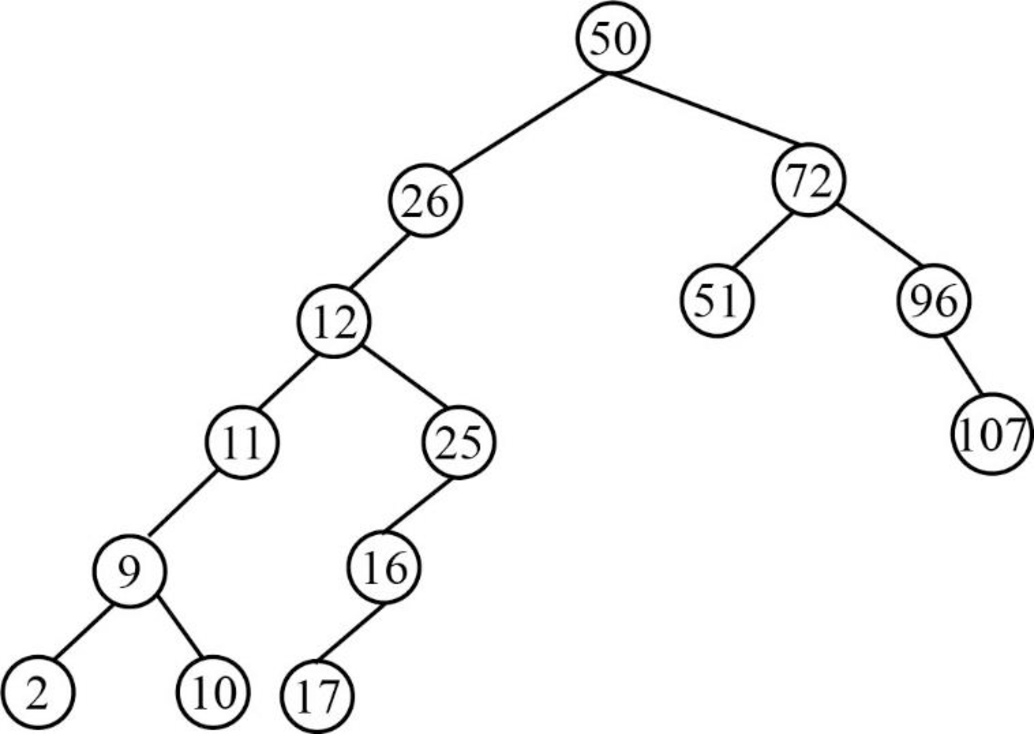
Step 15:
- Next element is 95, which is greater than root node element 50, so insert the element 95 as the right child of the root node.
- The root node already contains the element 72 as the right child and the element 95 is greater than the element 72.
- The element 72 already contains the element 96 as the right child and the element 95 is lesser than the element 96.
- So, insert the element 95 as the left child of 96.
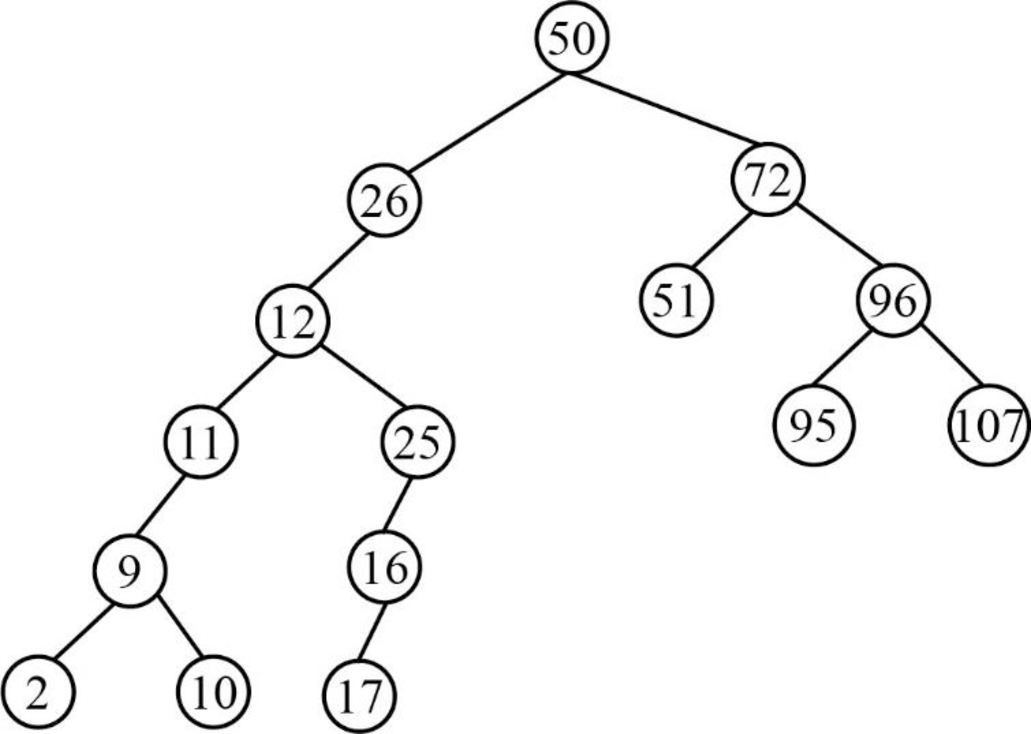
Therefore, the above tree is the final constructed binary search tree for the given elements.
Want to see more full solutions like this?
Subscribe now to access step-by-step solutions to millions of textbook problems written by subject matter experts!
Students have asked these similar questions
Q12- A three phase transformer 3300/400 V,has D/Y connected and working on 50Hz. The line
current on the primary side is 12A and secondary has a balanced load at 0.8 lagging p.f. Determine
the i) Secondary phase voltage ii) Line current iii) Output power Ans. (230.95 V, 99.11 A, 54.94 kW)
make corrections of this program based on the errors shown. this is CIS 227 .
Create 6 users: Don, Liz, Shamir, Jose, Kate, and Sal.
Create 2 groups: marketing and research.
Add Shamir, Jose, and Kate to the marketing group.
Add Don, Liz, and Sal to the research group.
Create a shared directory for each group.
Create two files to put into each directory:
spreadsheetJanuary.txt
meetingNotes.txt
Assign access permissions to the directories:
Groups should have Read+Write access
Leave owner permissions as they are
“Everyone else” should not have any access
Submit for grade:
Screenshot of /etc/passwd contents showing your new users
Screenshot of /etc/group contents showing new groups with their members
Screenshot of shared directories you created with files and permissions
Chapter 8 Solutions
COMPUTER SCIENCE ILLUMIN.-TEXT
Ch. 8 - Prob. 1ECh. 8 - Prob. 2ECh. 8 - Prob. 3ECh. 8 - Prob. 4ECh. 8 - Prob. 5ECh. 8 - Prob. 6ECh. 8 - Prob. 7ECh. 8 - Prob. 8ECh. 8 - Prob. 9ECh. 8 - Prob. 10E
Ch. 8 - Prob. 11ECh. 8 - Prob. 12ECh. 8 - Prob. 13ECh. 8 - Prob. 14ECh. 8 - Prob. 15ECh. 8 - Prob. 16ECh. 8 - Prob. 17ECh. 8 - Prob. 18ECh. 8 - Prob. 19ECh. 8 - Prob. 20ECh. 8 - Prob. 21ECh. 8 - Prob. 22ECh. 8 - Prob. 23ECh. 8 - Prob. 24ECh. 8 - Prob. 25ECh. 8 - Prob. 26ECh. 8 - Prob. 27ECh. 8 - Prob. 28ECh. 8 - Prob. 29ECh. 8 - Prob. 30ECh. 8 - Prob. 31ECh. 8 - Prob. 32ECh. 8 - Prob. 33ECh. 8 - Prob. 34ECh. 8 - Prob. 35ECh. 8 - Prob. 36ECh. 8 - Prob. 37ECh. 8 - Prob. 38ECh. 8 - Prob. 39ECh. 8 - Prob. 40ECh. 8 - Prob. 41ECh. 8 - Prob. 42ECh. 8 - Prob. 43ECh. 8 - Prob. 44ECh. 8 - Prob. 45ECh. 8 - Prob. 46ECh. 8 - Prob. 47ECh. 8 - Prob. 48ECh. 8 - Prob. 49ECh. 8 - Prob. 50ECh. 8 - Prob. 51ECh. 8 - Prob. 52ECh. 8 - Prob. 53ECh. 8 - Prob. 54ECh. 8 - Prob. 55ECh. 8 - Prob. 56ECh. 8 - Prob. 57ECh. 8 - Prob. 58ECh. 8 - Prob. 59ECh. 8 - Prob. 60ECh. 8 - Prob. 61ECh. 8 - Prob. 62ECh. 8 - Prob. 66ECh. 8 - Prob. 67ECh. 8 - Prob. 68ECh. 8 - Prob. 69ECh. 8 - Prob. 1TQCh. 8 - Prob. 2TQCh. 8 - Prob. 4TQ
Knowledge Booster
Similar questions
- ⚫ your circuit diagrams for your basic bricks, such as AND, OR, XOR gates and 1 bit multiplexers, ⚫ your circuit diagrams for your extended full adder, designed in Section 1 and ⚫ your circuit diagrams for your 8-bit arithmetical-logical unit, designed in Section 2. 1 An Extended Full Adder In this Section, we are going to design an extended full adder circuit (EFA). That EFA takes 6 one bit inputs: aj, bj, Cin, Tin, t₁ and to. Depending on the four possible combinations of values on t₁ and to, the EFA produces 3 one bit outputs: sj, Cout and rout. The EFA can be specified in principle by a truth table with 26 = 64 entries and 3 outputs. However, as the EFA ignores certain inputs in certain cases, it is easier to work with the following overview specification, depending only on t₁ and to in the first place: t₁ to Description 00 Output Relationship Ignored Inputs Addition Mode 2 Coutsjaj + bj + Cin, Tout= 0 Tin 0 1 Shift Left Mode Sj = Cin, Cout=bj, rout = 0 rin, aj 10 1 1 Shift Right…arrow_forwardShow the correct stereochemistry when needed!! mechanism: mechanism: Show the correct stereochemistry when needed!! Br NaOPh diethyl ether substitutionarrow_forwardIn javaarrow_forward
- KeanPerson #keanld:int #keanEmail:String #firstName:String #lastName: String KeanAlumni -yearOfGraduation: int - employmentStatus: String + KeanPerson() + KeanPerson(keanld: int, keanEmail: String, firstName: String, lastName: String) + getKeanld(): int + getKeanEmail(): String +getFirstName(): String + getLastName(): String + setFirstName(firstName: String): void + setLastName(lastName: String): void +toString(): String +getParkingRate(): double + KeanAlumni() + KeanAlumni(keanld: int, keanEmail: String, firstName: String, lastName: String, yearOfGraduation: int, employmentStatus: String) +getYearOfGraduation(): int + setYearOfGraduation(yearOfGraduation: int): void +toString(): String +getParkingRate(): double In this question, write Java code to Create and Test the superclass: Abstract KeanPerson and a subclass of the KeanPerson: KeanAlumni. Task 1: Implement Abstract Class KeanPerson using UML (10 points) • Four data fields • Two constructors (1 default and 1 constructor with all…arrow_forwardPlz correct answer by best experts...??arrow_forwardQ3) using the following image matrix a- b- 12345 6 7 8 9 10 11 12 13 14 15 1617181920 21 22 23 24 25 Using direct chaotic one dimension method to convert the plain text to stego text (hello ahmed)? Using direct chaotic two-dimension method to convert the plain text to stego text?arrow_forward
- : The Multithreaded Cook In this lab, we'll practice multithreading. Using Semaphores for synchronization, implement a multithreaded cook that performs the following recipe, with each task being contained in a single Thread: 1. Task 1: Cut onions. a. Waits for none. b. Signals Task 4 2. Task 2: Mince meat. a. Waits for none b. Signals Task 4 3. Task 3: Slice aubergines. a. Waits for none b. Signals Task 6 4. Task 4: Make sauce. a. Waits for Task 1, and 2 b. Signals Task 6 5. Task 5: Finished Bechamel. a. Waits for none b. Signals Task 7 6. Task 6: Layout the layers. a. Waits for Task 3, and 4 b. Signals Task 7 7. Task 7: Put Bechamel and Cheese. a. Waits for Task 5, and 6 b. Signals Task 9 8. Task 8: Turn on oven. a. Waits for none b. Signals Task 9 9. Task 9: Cook. a. Waits for Task 7, and 8 b. Signals none At the start of each task (once all Semaphores have been acquired), print out a string of the task you are starting, sleep for 2-11 seconds, then print out a string saying that you…arrow_forwardProgramming Problems 9.28 Assume that a system has a 32-bit virtual address with a 4-KB page size. Write a C program that is passed a virtual address (in decimal) on the command line and have it output the page number and offset for the given address. As an example, your program would run as follows: ./addresses 19986 Your program would output: The address 19986 contains: page number = 4 offset = 3602 Writing this program will require using the appropriate data type to store 32 bits. We encourage you to use unsigned data types as well. Programming Projects Contiguous Memory Allocation In Section 9.2, we presented different algorithms for contiguous memory allo- cation. This project will involve managing a contiguous region of memory of size MAX where addresses may range from 0 ... MAX - 1. Your program must respond to four different requests: 1. Request for a contiguous block of memory 2. Release of a contiguous block of memory 3. Compact unused holes of memory into one single block 4.…arrow_forwardusing r languagearrow_forward
- Programming Problems 9.28 Assume that a system has a 32-bit virtual address with a 4-KB page size. Write a C program that is passed a virtual address (in decimal) on the command line and have it output the page number and offset for the given address. As an example, your program would run as follows: ./addresses 19986 Your program would output: The address 19986 contains: page number = 4 offset = 3602 Writing this program will require using the appropriate data type to store 32 bits. We encourage you to use unsigned data types as well. Programming Projects Contiguous Memory Allocation In Section 9.2, we presented different algorithms for contiguous memory allo- cation. This project will involve managing a contiguous region of memory of size MAX where addresses may range from 0 ... MAX - 1. Your program must respond to four different requests: 1. Request for a contiguous block of memory 2. Release of a contiguous block of memory 3. Compact unused holes of memory into one single block 4.…arrow_forwardusing r languagearrow_forwardWrite a function to compute a Monte Carlo estimate of the Beta(3, 3) cdf, and use the function to estimate F(x) for x = 0.1,0.2,...,0.9. Compare the estimates with the values returned by the pbeta function in R.arrow_forward
arrow_back_ios
SEE MORE QUESTIONS
arrow_forward_ios
Recommended textbooks for you
 Database System ConceptsComputer ScienceISBN:9780078022159Author:Abraham Silberschatz Professor, Henry F. Korth, S. SudarshanPublisher:McGraw-Hill Education
Database System ConceptsComputer ScienceISBN:9780078022159Author:Abraham Silberschatz Professor, Henry F. Korth, S. SudarshanPublisher:McGraw-Hill Education Starting Out with Python (4th Edition)Computer ScienceISBN:9780134444321Author:Tony GaddisPublisher:PEARSON
Starting Out with Python (4th Edition)Computer ScienceISBN:9780134444321Author:Tony GaddisPublisher:PEARSON Digital Fundamentals (11th Edition)Computer ScienceISBN:9780132737968Author:Thomas L. FloydPublisher:PEARSON
Digital Fundamentals (11th Edition)Computer ScienceISBN:9780132737968Author:Thomas L. FloydPublisher:PEARSON C How to Program (8th Edition)Computer ScienceISBN:9780133976892Author:Paul J. Deitel, Harvey DeitelPublisher:PEARSON
C How to Program (8th Edition)Computer ScienceISBN:9780133976892Author:Paul J. Deitel, Harvey DeitelPublisher:PEARSON Database Systems: Design, Implementation, & Manag...Computer ScienceISBN:9781337627900Author:Carlos Coronel, Steven MorrisPublisher:Cengage Learning
Database Systems: Design, Implementation, & Manag...Computer ScienceISBN:9781337627900Author:Carlos Coronel, Steven MorrisPublisher:Cengage Learning Programmable Logic ControllersComputer ScienceISBN:9780073373843Author:Frank D. PetruzellaPublisher:McGraw-Hill Education
Programmable Logic ControllersComputer ScienceISBN:9780073373843Author:Frank D. PetruzellaPublisher:McGraw-Hill Education

Database System Concepts
Computer Science
ISBN:9780078022159
Author:Abraham Silberschatz Professor, Henry F. Korth, S. Sudarshan
Publisher:McGraw-Hill Education

Starting Out with Python (4th Edition)
Computer Science
ISBN:9780134444321
Author:Tony Gaddis
Publisher:PEARSON

Digital Fundamentals (11th Edition)
Computer Science
ISBN:9780132737968
Author:Thomas L. Floyd
Publisher:PEARSON

C How to Program (8th Edition)
Computer Science
ISBN:9780133976892
Author:Paul J. Deitel, Harvey Deitel
Publisher:PEARSON

Database Systems: Design, Implementation, & Manag...
Computer Science
ISBN:9781337627900
Author:Carlos Coronel, Steven Morris
Publisher:Cengage Learning

Programmable Logic Controllers
Computer Science
ISBN:9780073373843
Author:Frank D. Petruzella
Publisher:McGraw-Hill Education